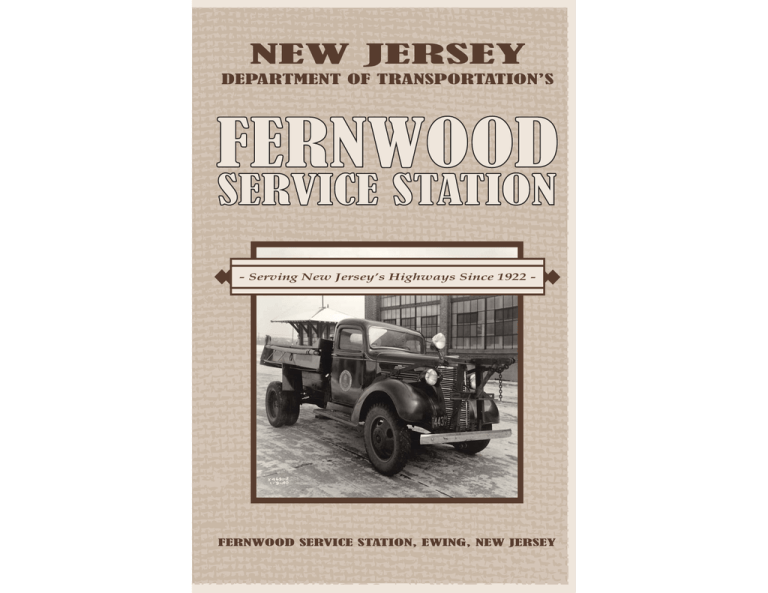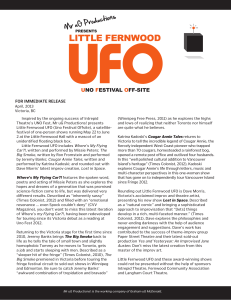FERNWOOD SERVICE STATION NEW JERSEY DEPARTMENT OF TRANSPORTATION’S
advertisement

NEW JERSEY DEPARTMENT OF TRANSPORTATION’S FERNWOOD SERVICE STATION - Serving New Jersey’s Highways Since 1922 - FERNWOOD SERVICE STATION, EWING, NEW JERSEY Plowing for Victory Gardens at Fernwood, 1943. CONTENTS INTRODUCTION FROM FERNWOOD SERVICE STATION TO NJDOT HEADQUARTERS ........................................................ 1 THE STATE HIGHWAY DEPARTMENT’S EARLY YEARS .................. 3 WAR SURPLUS TO THE RESCUE ...................................................... 5 BUILDING THE FERNWOOD SERVICE STATION, 1921‐26 ........... 7 Aerial view of the Fernwood Complex, Circa 1962. SNOW REMOVAL .............................................................................. 13 FERNWOOD IN THE 1920s AND THE 1930s................................... 15 BEAUTIFICATION OF FERNWOOD A BACKGROUND OF GREEN ...................................................................................... 25 CONSOLIDATING HEADQUARTERS OPERATIONS, 1935‐1960 .................................................................................... 27 FERNWOOD FROM THE 1960s TO TODAY ..................................... 31 Cover: State Highway Department Truck at Fernwood, 1940. Building No. 1 and Fueling Station in background. Fernwood Service Station NOTES ON SOURCES ....................................................................... 34 served as a depot for receiving and storing road-building materials, most delivered via a railroad siding. During its first two decades of operation in the 1920s and 1930s, Fernwood added warehouses and shops for sign making, blacksmithing, electrical lighting, painting, carpentry and other crafts necessary for maintaining highway infrastructure. Fernwood Service Station, Architectural Rendering by the New Jersey State Highway Department, Division of Bridges, September 1921. INTRODUCTION From Fernwood Service Station to NJDOT Headquarters Fernwood was not intended to become the NJSHD’s headquarters. In the 1920s, it was assumed that the headquarters would always remain in downtown Trenton near the State House and the center of state politics. In 1935, however, the NJSHD’s Laboratory Division moved from a cramped building it shared with the Department of Conservation and Development at 60 Capitol Street in Trenton to a new laboratory, known as Building #18, at Fernwood. This signaled the first of several moves of personnel from crowded downtown facilities to the suburban Fernwood location, which had ample space for expansion. In 1949-50, the department relocated the bulk of its administrative and engineering personnel from the State House Annex in Trenton, which it shared with other state agencies, to a Main Office Building that was built adjacent to the Fernwood Service Station. Later additions to the headquarters include the Finance and Administration Building, built in 1969; the Foran Building, built in 1984; and the Engineering and Operations Building, built in 1987. The Fernwood Complex is a collection of some two-dozen buildings at the New Jersey Department of Transportation (NJDOT) Facilities Headquarters located in Ewing Township outside Trenton. Fernwood has been a center for maintaining vehicles, mowers, snow plows and other tools, signs and equipment necessary for the safe and efficient operation of New Jersey’s highways since 1922. It is the oldest part of the headquarters. Fernwood’s original proper name was the Fernwood Service Station of the New Jersey State Highway Department (NJSHD). Later, after the NJSHD was reorganized as NJDOT in 1966, it became simply the Fernwood Complex, a grouping of low, one-story, factory-like buildings located in the southwest corner of a much larger headquarters facility. Fernwood’s purpose starting in 1922 was to keep the department’s fleet of trucks and construction equipment running and “on the road.” A 40,000-square-foot garage, still in existence and known as Building #1,* was built specially for this purpose. Fernwood also * Fernwood’s buildings were numbered sequentially starting in the 1920s, but as time passed and buildings were replaced, numbers were reassigned or sometimes dropped altogether. For purposes of consistency, the current-day numbers and names are used throughout this document. 1 Fernwood Service Station Changing a Tire at Fernwood, 1954. 2 Commission authority over the Ocean Highway, the precursor to U.S. Route 9 from Atlantic Highlands to Cape May. This was designed mainly to promote tourism. A more sweeping law passed in 1912 created a 1,500-mile State Highway System connecting the state’s regions and urban centers. Political and financial challenges, however, prevented the state from taking over direct responsibility for constructing or maintaining these highways, and there was little call for the commission to own equipment or employ its own maintenance forces. Dirt Road, Far Hills, New Jersey, Circa 1898-1905. THE STATE HIGHWAY DEPARTMENT’S EARLY YEARS Understanding the history of the Fernwood Service Station requires some background on the development of centralized state control of highways in New Jersey in the decades leading up to the 1920s. The State of New Jersey was one of the first states in the nation to pass laws intended to give state government a greater say in the improvement of roads, which traditionally had been within the purview of local government. In 1894, the Legislature created the office of State Commissioner of Public Roads, the precursor to the future NJSHD and NJDOT. Initially, the commissioner’s duties were to collect data on the condition of New Jersey roads, not to actually maintain or build them. It was hoped that the data collected would promote interest in upgrading rural roads to help farmers “get out of the mud” and deliver their products to market. Reflecting this outlook, the commissioner’s office was initially located within the New Jersey Department of Agriculture. Recreational bicyclists were also an important constituency within the good roads movement, a loose collection of progressive reformers who believed better roads would improve the lives of isolated rural Americans by connecting city to countryside. Over the next 25 years, New Jersey’s state government gradually expanded its control over the state’s main highways, gaining momentum with the growing popularity of automobiles. A law passed in 1909 gave a new State Highway Eventually, the federal government jumpstarted New Jersey’s highway program. The Federal Aid Road Act of 1916, passed by Congress and signed by President Woodrow Wilson, a former New Jersey Governor, for the first time provided direct funding to all states. The law specified that states needed to have professionally staffed state highway departments to administer the federal funds. In response, in 1917, the New Jersey Legislature reformed the State Highway Commission, placing it in charge of a department staffed by professionally qualified engineers. It also authorized the department to take over and operate the State Highway System. In the midst of these organizational changes, the United States entered World War I. New Jersey’s highways were suddenly critical to the delivery of war supplies from the Midwest to the Port of New York, a situation that developed when the nation’s rail system snarled, idling a large portion of the rolling stock. To no one’s surprise, state highways in New Jersey and other states proved inadequate to the reliable delivery of goods by motor freight, especially during the difficult winter of 1917-18. Actual construction on New Jersey’s State Highway System began in 1918, but the NJSHD found it necessary to work through private contractors and consulting engineers since its staff was small and it lacked manpower and equipment. New Jersey’s experience, similar to that of many other states, raised concerns in Washington that although new highways were being built, the investment would go to waste due to inadequate state oversight and provisions for future maintenance. Other inefficiencies were exposed, such as the states’ inability to undertake small improvements and repairs on their own, as well as the inability to purchase materials in bulk and deliver those materials to construction sites. Good Roads Reformer Checking Highway Conditions, circa 1915. 3 Fernwood Service Station 4 the maintenance function of state highway departments, specifying that federal aid could be withheld from those states that failed to maintain any road constructed with federal funds. War Surplus Trucks Equipped with Snow Plows, Circa 1921. The influx of vehicles and equipment was a boon to the NJSHD’s abilities to carry out highway repairs and maintenance using its own forces, but it created the need for a place to service the equipment. A small garage the department rented on Ellis Alley in downtown Trenton, a few blocks from the State House, was inadequate for the job. The short-term answer was to rent a larger garage, which the department did in 1920, leasing a 25,000-square-foot building at Trenton Junction in Ewing Township, just outside the city limits. In July 1920, a newly established NJSHD Equipment Division (later renamed the Division of Plant and Equipment) took charge of the trucks, automobiles and construction equipment. The head of the division, engineer Norman Clarke Applegate, reported directly to the State Engineer, reflecting the importance of the division’s mission. WAR SURPLUS TO THE RESCUE Coring Rig Mounted on the Rear of a One-Ton Truck Used for Recovering Test Cores from Pavements, 1928. Congress decided to resolve the dilemma of poorly equipped state highway departments by authorizing the Secretary of War to transfer surplus equipment, left over from World War I, to the states. In June 1919, more than 20,500 motor trucks were allocated at no cost (other than delivery) to the states, with New Jersey accepting approximately 200 trucks (mostly Model T, one-ton trucks), as well as a smaller number of automobiles, caterpillar tractors, and other miscellaneous pieces of equipment and construction materials. Over the course of the next three years, the NJSHD continued to accept surplus equipment and purchase some new equipment, so that by April 1922 its fleet consisted of 417 motor vehicles (cars and trucks) and approximately 175 other pieces of power equipment, including rollers, tractors, concrete mixers, steam shovels and pumps. State highway employees were ingenious in converting some of the war-surplus trucks to specialized uses, including as a sprayer of whitewash (used to coat the bases of utility poles and trees to make them visible to drivers) and as a concrete-coring rig (used to take samples of concrete for analysis at the state lab). The Federal Highway Act of 1921 strengthened 5 Fernwood Service Station 6 Fernwood Service Station, Architectural Rendering by the New Jersey State Highway Department, Division of Bridges, September 1921. BUILDING THE FERNWOOD SERVICE STATION, 1921‐1926 In 1921, the NJSHD purchased a 22-acre farm tract (later expanded to 36 acres) near the southwest corner of Lower Ferry Road and Scotch Road (later known as Parkway Avenue) for the site of a new service station for its fleet of vehicles and construction equipment. This location was about one mile southeast of Trenton Junction where the state had previously rented a garage. It was within a 15-minute drive of the department’s downtown offices, but far enough out of the city that state vehicles did not have to pass over city streets and through downtown traffic congestion to be deployed to the mostly rural state highway system. It had the necessary open space for the construction of maintenance and storage facilities, and access to an active rail line that could handle bulk shipments. The parcel’s southwestern boundary was the Trenton Branch of the Philadelphia and Reading Railroad, near a passenger stop, actually a small wood platform, named Fernwood by the railroad in 1877 after an old alternate name for Lower Ferry Road. 7 Fernwood Service Station Interior of Building #1, Built in 1922. Photograph dates to 1949. By September 1921, engineers of the NJSHD’s Division of Bridges had completed plans for a one-story, brick service station, measuring 400 feet by 100 feet, with steel-sash windows, exposed steel-truss roof and a wood-block floor. In early 1922, a construction contract was awarded to the Austin Company, a general contractor based out of Philadelphia. This building, known as Building #1, was the first constructed at the new Fernwood Service Station. It housed a machine shop, stock room, and bays for general repair work on trucks and highway maintenance equipment. 8 From its inception, the Equipment Division at Fernwood thought of itself “as a trucking or equipment contractor” to the NJSHD’s other divisions. Work done for the divisions was even charged to those divisions’ accounts. On the wall at Fernwood was a large state map with colored pins indicating the position of every piece of equipment. Using telephones, and later radios, drivers were ordered to move the equipment where and when it was needed. Over time, about 80 percent of the work handled at Fernwood was for the Maintenance Division, although other divisions, and even other state agencies, relied on Fernwood for trucks, cars and supplies. Building #2, Built in 1923. Looking north at rear. Note the elevated railroad track where cars could dump bulk materials into concrete bunkers. Photograph dates to 1949. 9 Fernwood Service Station The Fernwood Service Station was the “one central repair shop” where all types of work from routine inspection to engine reconstruction were done. Fernwood, however, rarely had hundreds of vehicles parked in its lots. Under normal circumstances, vehicles were stationed at small satellite garages and sub-stations throughout the state and only brought to Fernwood for inspection and maintenance, often in the winter when fieldwork was slow. During the construction season, mechanics were dispatched from Fernwood to fix broken equipment in the field so as to maintain project schedules. Their stated goal was to be able to reach any point in the state within three to four hours. In addition to Building #1, the Fernwood Service Station consisted of Building #2, a gambrel-roofed concrete-block building used for storage and a coalfired, low-pressure steam plant. Buildings #1 and #2 were served by railroad spurs; the spur adjacent to Building #1 was depressed for its last 100 feet, allowing for the off-loading of up to four rail cars at ground level, whereas the spur to the rear of Building #2 wass el elevated on a trestle, allowing hopper cars rs to dump bulk materials such as coal,, sand and gravel into concrete bunkers. Building #3 was a small pump p house used to draw water from m an artesian well. Over the pump p house was a steel water tower ris-ing 100 feet above ground level.l. This gravity tank supplied thee facility with water for washing trucks and equipment, and for pressurizing an automatic fire sprinkler system and fire hydrants. Building #25, the grease shop, was a small brick building to the rear of Building #1, with grease pits for lubricating vehicles. This original shop was rebuilt about 1940 and is used Gravity Water Tank and Tower, Built Circa 1922-23 today for storage. (no longer extant). Photograph dates to 1949. 10 Building #4, Paint Shop, Built Circa 1924 (no longer extant). Photograph dates to 1949. Between 1923 and 1926, the Fernwood Service Station continued to expand with the construction of Buildings #4 and #16 (a paint shop and storage, no longer extant) and Buildings #5, #7 and #8, all warehouses. Without doubt the most unusual of the buildings erected during the mid-1920s were Buildings #4, #5 and #16, prefabricated steel-frame structures, which were war surplus, like so much of the NJSHD’s first-generation equipment. Specifically, the buildings were Truscon buildings, trademarked “kits” manufactured by the Truscon Steel Company of Youngstown, Ohio. These buildings were marketed Truscon Standardized Steel Buildings Catalogue, Circa 1920. Building #5 at the Fernwood Service Station is similar to a Series “A” Type 3, pitched-roof building. 11 Fernwood Service Station as low-cost, quick-to-erect, “100% salvage value” structures, suitable for a wide range of military, industrial and commercial uses. Due to the modular nature of the design, buildings of almost any size could be achieved by adding bays to the steel frame. No special tools or training were required for assembly since the connections were simple pins and wedges. Fernwood’s own maintenance staff erected Building #5, the only surviving example on site. This building also housed an operation for casting the concrete monuments used to mark stateowned rights-of-way. In the late 1920s, Fernwood turned out over 1,500 monuments on an annual basis. Cover of Catalogue for Truscon Standardized Steel Buildings, Circa 1920. Building #5, Storage Building. View looking northwest. A prefabricated “Truscon” building, it was acquired as army surplus about 1925. Photograph dates from 1949. 12 Attaching Plow to Truck for Snow Removal, 1950. SNOW REMOVAL From the very beginning, one of the most important functions carried out at the Fernwood Service Station was preparing the state’s trucks and equipment for snow removal each winter. In fact, the process of sharpening and straightening plows, and then attaching them to the trucks, was a carefully choreographed responsibility that took place between the end of the construction season, usually in late October, and the beginning of winter. The deployment of the snow plows to their winter on-call stations, often by convoy, was perhaps the most highly anticipated event each year at Fernwood, and a majority of the photographs taken at Fernwood over the years have featured snowWalter “Snow Fighter” Truck and Plow at Work, removal equipment. 1945. 13 Fernwood Service Station The idea that highways should be kept open throughout the winter was a relatively new idea in the early decades of the 20th century. After all, most travel of any distance was undertaken by train, and people took it for granted that highway travel in winter weather would be limited and, for long periods of time, impassable. Snow Snow Plows Line Up at Fernwood, Ready to Go into the Field for Winter Use, 1950. removal on state highways only began during World War I with the Pennsylvania State Highway Department making valiant efforts to keep the Lincoln Highway open to convoys of Army trucks headed east to the ports of Philadelphia and New York City. In 1919-1920, New Jersey made its first attempt at snow removal on state highways, employing 22 trucks with snow plows. The following winter 74 plows were in use, allowing the NJSHD to keep the State Highway System open throughout the season. This was probably the largest state fleet of snow plows in use in the United States, considering that only 184 truck plows were in use in 36 states during the next winter of 1922-1923. By 1925, the Equipment Division at Fernwood reported that New Jersey’s drivers were accustomed to having “access to the pavement” throughout the winter. Worker with Foul-Weather Gear at Salt Spreader Control, 1961. Preparing for winter continues to be a number one priority at Fernwood. For many years, Building #2 has served as the plow shop, where plows are straightened and repaired prior to mounting on the trucks at the start of winter. The technology of plowing has changed little over the decades, although trucks have increased significantly in size, power and speed. 14 Buildings #7, 8, 11, 17 and 20 (left to right), Built from 1923 to 1935. Photograph from 1949. Building #s 7, 8, 11, 17 and 20 (left to right), 1949. FERNWOOD IN THE 1920s AND THE 1930s A Selection of the Equipment Maintained at the Fernwood Service Station. From New Jersey State Highway Department, Annual Report, 1940. Fernwood’s capabilities expanded to cover a variety of miscellaneous jobs, from the repair of movable bridge mechanisms to fixing broken office furniture. The principal classifications of Fernwood employees were mechanics, welders, machinists, carpenters, painters, truck drivers and common laborers. During the 1920s, the NJSHD grew from a small understaffed department into the state’s largest institution, whether measured by the amount of money involved, workers employed or the results obtained. At the Fernwood Service Station, the primary focus was keeping the fleet on the road. State trucks and automobiles were easily averaging 30,000 to 60,000 miles per year with maintenance costs increasing as the vehicles aged. By the mid-1920s, the war-surplus trucks were on their last legs, and Fernwood implemented a program of retiring worn-out equipment and purchasing new 3-ton and 5-ton trucks from Ford, Mack and Chevrolet. Still, in 1927, Fernwood performed more than 1,640 repair jobs, much of it on older equipment. Jacob Hagin (1886-1938), Superintendent of Plant and Equipment, oversaw the work at Fernwood from about 1925 to 1938. Judging by his annual reports to the State Highway Engineer, he kept on top of the details and was vigilant of the financial bottom line, constantly looking for ways to improve Fernwood’s operation. He also was an advocate for Fernwood’s physical plant, which grew from about a half dozen to two-dozen buildings during his tenure. 15 Fernwood Service Station Joseph J. Odas, blacksmith, Straightening Part of a Snow-Plow Frame, 1972. 16 Hagin, unlike most of the NJSHD’s senior staff, was not an engineer by training. Born in 1886, he was the son of Russian Jewish immigrants who settled in Elizabeth, New Jersey. In his teens and early 20s, he worked as a drug store clerk in Elizabeth, but sometime in his late 20s, he became a manager at an automobile dealership. It was probably this experience that brought him in touch with the NJSHD and its need to manage its large fleet of trucks and cars. Hagin recognized the costs of maintaining older vehicles and the long-term financial advantages of regularly rotating vehicles out of service and replacing them with new models, an approach that he promoted and implemented at Fernwood. Storing materials for roadway maintenance was a big part of Fernwood’s function. These materials were purchased in bulk and requisitioned at opportune times to obtain low competitive prices. In 1929, for example, Fernwood handled large quantities of calcium chloride, concrete reinforcing steel, forms for pouring concrete roadway, joint filler, stop signs, route marker signs, sign posts and paint. Warehouse space was at a premium, so state crews built a series Fernwood Service Station, Looking Southwest at Building # 1. The small hipped-roof building was a fueling station (Building #10, non-extant). Note the concrete pavement and the depressed grade for the railroad siding in the foreground. Photograph dates to 1949. 17 Fernwood Service Station of new gambrel-roofed concreteblock warehouses – Building #11 (1932), Building #17 (1934), Building #18 (1935), Building #21 (1938) and Building #23 (1939). Some activities, such as electrical work, blacksmithing and carpentry, which had previously been housed in Building #1, were moved into shops sectioned out of the warehouses. Space in some of the warehouses was loaned out to other state agencies, including the Commissioner of Alcoholic Beverages and the Commissioner of Finance. Building #9, Wash House, Built Circa 1930. View looking northeast. Photograph dates to 1949. While there is no evidence that Fernwood’s buildings were laid out to a master plan, there is a certain logic to their function and relationships. The buildings are oriented in three rows with paved roadways between each row. The buildings have open floor plans, large bay doors, and expanses of windows providing natural light. Chronologically, Buildings #1 and #2 are the first row, and they were laid out with their long axes perpendicular to the Trenton Branch railroad. This allowed for a railroad siding, no longer extant, to parallel Building #1’s north side, facilitating off-loading of supplies and equipment either south into Building #1 or north directly onto a concrete apron. Buildings #7, #8, #11, #17 and #20, built from 1923 to 1935, defined the second row; these were warehouses, having nearly identical footprints of 60 feet by 260 feet, laid out with their long axes perpendicular to Building #1 and parallel to the railroad. A third row of warehouses, diSnow Plow Blade Being Placed on a Truck at Fernwood, 1950. rectly behind the second row, 18 3 11 ƤƤ 4 16 2 N 5 25 1 ȋȌ 7 8 10 1926 Building #20, Built Circa 1935. Photograph dates to 1949. was built from 1938 to 1940 and consisted of Buildings #6, #21 and #23. The exception to this pattern was Warehouse #24, built circa 1935, which was oriented to its own rail spur to the northwest of the other buildings. Alleys between the warehouses allowed for access to bay doors located in the side elevations. ȋ Ȍ FERNWOOD SERVICE STATION Buildings Constructed from 1922 to 1926 Building The “Hypressure Jenny,” a Pressure Washer, Was Employed at Fernwood in Building #9 to Wash Trucks and Other Equipment. Homestead Valve Manufacturing Company, circa 1930. 19 Fernwood Service Station Sta attiion on 1 2 3 4 5 7 8 10 11 16 25 Function Year Built Motor Vehicle Repair Shop Storage/Sign Shop Water Pump House and Tower Paint Shop Storage Storage Storage Fueling Station Hoisting Engine to Unload Railroad Cars Paint Storage Grease Shop 1922 1923 1922 1924 1925 1923 1923 c. 1923 c. 1923 c. 1925 c. 1923 20 incinerator N N 9 24 17 20 21 Lower Ferry Road (Fernwood Road) 6 23 Lower Ferry Road (Fernwood Road) 11 1A 22 1940 CP 18 1960 18 A MOB gatehouse Parkway Avenue (or Scotch Road) Parkway Avenuee (or Scotch Road) FERNWOOD SERVICE STATION FERNWOOD SERVICE STATION Buildings Constructed from 1927 to 1940 Buildings Constructed from 1941 to 1960 Building 6 9 11 17 18 20 21 23 24 CP 21 19 Function Storage Vehicle Wash Garage Storage Lab Electrical Shop Paint and Carpentry Shop Storage Warehouse Chlorinating Plant Fernwood Service Station Year Built 1940 c. 1931 1932 1934 1935 c. 1935 1938 1939 c. 1935 c. 1938 Building 1A 18A 19 22 MOB Function Truck Maintenance Lab Plant Maintenance Switch Gear Building Main Office Building Year Built c. 1955 1953 c. 1960 c. 1960 1949 22 Building Thiokol 16 9 2 N 28 5 4 24 A B 1B 2013 1 1A 8 6 11 26 17 23 20 21 22 2 Foran 19 Lower Lower Ferry Ferry Road Road (Fernwood (Fernwood Road) Road) 25 7 E&O CSP 18 A F&A 18 MOB Parkway Avenuee (or Scotch Road) NEW JERSEY DEPARTMENT OF TRANSPORTATION FACILITIES HEADQUARTERS Building 1 1A 1B 2 4 5 6 7 8 9 23 Function Repair Shop Mower/Machine Shop Storage Plow shop Plant Maintenance Storage Furniture and Storage Equipment/Receiving Pavement and Radio Shop Plow Shop Storage Fernwood Service Station Year Built 1922 1953 1940 1923 c. 1970 1925 1940 1923 1923 c. 1931 11 16 17 18 18A 19 20 21 22 23 24 24A 24B 26 28 MOB F&A CSP Foran E&O Function Year Built Inspection Coring Storage Construction Vacant Vacant Plant Maintenance Electrical Shop Sign Shop Switch Gear Overhead Sign Shop Warehouse NJ Dept. of Health NJ Dept. of Criminal Justice Body Shop Cultural Resources Lab Main Office Building Finance & Administration Central Steam Plant Foran Building Engineering & Operations 1932 c. 1970 1934 1935 1953 c. 1960 c. 1935 1938 c. 1960 1939 c. 1935 c. 1975 c. 1975 c. 1979 c. 1975 1949 1969 c. 1980 1984 1987 Trainees of the Organized Reserve Corps (Army Reserve) Receive Instruction on Bulldozer Operation from a Reserve Officer Employed by the NJSHD, circa 1950. 24 Plowing for Victory Gardens at Fernwood during World War II, 1943. Driving the tractor is State Highway Commissioner Spencer Miller, Jr. The man at the plow is unidentified. Keeping up appearances also applied to the vehicle fleet. In 1931, Fernwood constructed a wash house, Building #9, a 28 by 38-foot wood-frame building. It housed a “Hypressure Jenny,” a type of power washer that used a mixture of alkali and water to remove grease and mud from vehicles. One man could give a truck a thorough cleaning in a few hours, whereas before it had taken up to two days to do the same job with a hand scraper. At the same time that the wash house was built, Fernwood connected to city water since the wash house so quickly depleted the supply of water pumped from the artesian well. From about 1931 on, the water pumped into the tower was mostly held in reserve for the fire sprinkler system. About 1986, the pump house and water tower were demolished. BEAUTIFICATION OF FERNWOOD – A BACKGROUND OF GREEN An emphasis at Fernwood in the 1930s was improving the appearance of the grounds, in harmony with the department’s stated goal of becoming a leader in roadside beautification. The vacant unkempt fields fronting the Fernwood complex were plowed and planted with grass to establish broad swaths of lawn. A small nursery was also established for shrubs and trees to be nourished until they could be transplanted for roadside landscaping, especially at interchanges and traffic circles. Most of these plants were salvaged from highway construction projects and otherwise would have been destroyed. Drives were neatly paved with crushed gravel and lined with white-painted stones. In 1932, a gatehouse was built at the Parkway Avenue entrance with a watchman on duty from 7:00 a.m. to 5:30 p.m. In the late 1930s, a formal parking lot was established near the entrance. Traffic islands separated incoming and outgoing traffic. Flowering shrubs were planted in the islands, providing “a striking contrast against a background of green lawn, darker evergreens and oaks.” A small chlorination plant was also constructed to treat Fernwood’s sewage and comply with local sanitation ordinances. 25 Fernwood Service Station Gatehouse, 1949. Generally speaking, the Great Depression was an active period at Fernwood, in part because the NJSHD adopted a strategy of doing for itself what otherwise might have been done by outside contractors. Furthermore, federal New Deal programs that paid for highway work, like the Works Progress Administration (WPA), placed an emphasis on keeping workers employed. In 1932, in order to not have to layoff workers, Fernwood decreased its work hours from 49 to 40 hours per week, eliminating a half-day Saturday shift and reducing the work day from 9 to 8 hours. The NJSHD also closed a small garage in downtown Trenton where it had kept cars for senior management and moved those cars to Building #8 at Fernwood. From then on, drivers were kept on call at Fernwood, ready to taxi vehicles downtown upon request. 26 The Main Gate at Fernwood, Circa 1960. The complex’s water tower is visible in the background. CONSOLIDATING HEADQUARTERS OPERATIONS, 1935-1960 ers and encouraged caution. Snow-plow trucks were also provided with lights on gimbal-type brackets, so that the lights could be adjusted to be better seen by traffic. About this time, Fernwood procured a fire truck with employees participating in fire safety drills. During World War II, the enhanced fire-safety capability at Fernwood was placed on-call to help fight fires that might break out at the nearby General Motors and Eastern Aircraft plants on Parkway Avenue. These critical warBlacksmithing at Fernwood, 1968. time industries were feared to be targets for sabotage or bombing raids. A traffic light was installed at the Parkway Avenue entrance to improve the safety of the intersection due to the heavy traffic generated by the factories. Jacob Hagin, Fernwood’s Superintendent of Plant and Equipment who had done so much to improve the facility, died in 1938. His replacement was Frank C. Young (1896-1957), a native of Ohio who had served in the U.S. Navy during World War I. After the war, he moved to Bridgewater, New Jersey, and became an insurance salesman, before joining the NJSHD to take up Hagin’s post. Despite his lack of experience in engineering or automotive mechanics, Young was a competent manager who sustained Fernwood as the department’s central repair shop. He served as the division superintendent until his death in 1957. Following national trends to promote safety in the workplace, Young emphasized operational safety in his annual report on Fernwood’s operations. About 1940, Fernwood began repainting the state’s trucks and equipment a bright yellow color, instead of the standard dark green adopted in the early 1920s. This decision was based on evidence that yellow vehicles were more visible to driv- 27 Fernwood Service Station Welding Safety Inspection at Fernwood, 1971. The inspector (right), identified as George Rightmire, is checking for dangerous gases, while the welder (left), identified as Fred Mason, works. 28 Sign Painting, Circa 1950. During the late 1930s, NJSHD officials were already considering the possibility of consolidating headquarters operations at Fernwood, due to the crowded office conditions in downtown Trenton, but no comprehensive study or decision had been made. The department had contributed $500,000 toward the construction of the State House Annex in 1928-31, but had quickly outgrown the building, which was shared with other state agencies. The movement of personnel from downtown to Fernwood began in 1935 when the Laboratory Division occupied a new lab building (Building #18) near the entrance to the Fernwood Service Station. The Art Deco-inspired architectural styling was completely different than the utilitarian structures previously built and perhaps reflected future aspirations for the Fernwood property. Any such plans were put on hold by World War II, but in 1948, the state approved plans to construct a new Main Office Building at Fernwood. Designed by the Trenton architectural firm of Micklewright and Mountford, this double-Y-plan building had Art Moderne-style influences with strong horizontal lines emphasized by brick bands and glass windows. In 2002, this building was renamed the David J. Goldberg Transportation Building after the first Commissioner of Transportation who served from 1966 to 1970. A Delegation of Engineers from the Philippines Inspects Mowers at Fernwood, 1954. Second from right is Frank C. Young, SHD Supervisor of Plant and Equipment. The consolidation of NJSHD headquarters at Fernwood coincided with very few physical changes at the old Fernwood Service Station itself. Only a small number of new shop or warehouse buildings were constructed in the 1950s. The most important new construction was an expansion, known as Building #1A, to the southeast corner of Building #1, added in about 1955 to provide needed space for truck and mower maintenance. Reflecting these changes in status, the Division of Plant and Equipment at Fernwood Service Station ceased to exist about 1960. Fernwood receded in importance on the department’s organizational chart to be placed under charge of a Bureau of Equipment within the Division of Maintenance and Operations. The new head of the Fernwood Service Station, the Master Mechanic, no longer lo reported directly to the state engineer’s offi o ce, but to the Assistant Chief of the Division of Maintenance and Operations. In many ways, this brought the state’s divisional structure more in concert with the typical practice of other state highway departments where equipment was rarely accorded the status of its own division. It Building #25, Grease House, Built Circa1940. signaled the end of an era at Fernwood. Photograph dates to 1949. 29 Fernwood Service Station 30 Building #5, 2014. FERNWOOD FROM THE 1960s TO TODAY Since 1960, most of what has happened to the Fernwood Complex’s buildings can be characterized as routine maintenance, repair and modernization. New construction has been minimal; two annexes were built onto the side of Building #24 in the mid-1970s, and a vehicle body shop, Building #26, was constructed between Buildings #11 and #17 in the late 1970s. A new truck wash and covered fuel pumps have been added in recent years. Most of the utilitarian buildings that were built in the 1920s and 1930s remain, although some have substantial changes to doors, windows and roof materials. Inside, equipment has been updated and many of the processes, such as those for making signs, entirely modernized. Today, Fernwood has been integrated within a bustling headquarters campus that houses a variety of building types that support NJDOT’s mission as a state transportation agency. What were once lawns and a tree nursery, Fernwood’s “background of green,” are now paved parking lots and multi-story office buildings. In 1969, a three-story annex, dubbed the Financial and Administration Building, was added to the southeast end of the Main Office Building. In the 1980s, a major spurt of construction occurred in response to a need to consolidate NJDOT’s offices and lessen the reliance on rented office space, as 31 Fernwood Service Station Interior of Building #s 1 and 1A, 2014. Building #2, Plow Shop, 2014. 32 NOTES ON SOURCES View Toward Entrance of Fernwood Complex. Building #s 8, 11, 17 and 20 (left to right), 2014. well as to address new planning and environmental responsibilities. By 1984, a new lab building, named after New Jersey State Senator Walter E. Foran, was constructed along Farrell Avenue, to the south of the old lab, Building #18, which was shortly thereafter vacated. The Foran Building housed new lab and office facilities for environmental support staff in the Bureau of Environmental Analysis and Operations and Maintenance units. Three years later, a sevenstory addition, called the Engineering and Operations Building, was built to connect with the Main Office Building. During this time, a new centralized steam plant was also constructed on the site of the former chlorinating plant to provide heat to the headquarters complex. Since 1990, the purchase of the former Thiokol Chemical Corporation buildings, located on the western side of the Trenton Branch railroad, has provided additional space needed by NJDOT. Still, the Fernwood Complex remains a distinguishable entity within the headquarters, reflecting its original and ongoing mission to keep NJDOT “on the road.” Attaching Plow to Truck for Snow Removal, 1950. 33 Fernwood Service Station This booklet was developed in response to a requirement by the Federal Emergency Management Agency (FEMA) for participation in the cost of repairs to several buildings in the Fernwood Complex that sustained damage from Superstorm Sandy in 2012. Information compiled initially by NJDOT cultural resources staff and a draft manuscript, The History of NJDOT at Fernwood, prepared by NJDOT archaeologist David C. Mudge provided the basis for completing Section 106 [of the National Historic Preservation Act of 1966 as amended] consultation. This more descriptive history has been written to increase availability of the information to the public. Hunter Research, Inc., conducted additional research in primary and secondary sources. Particularly useful were NJSHD Annual Reports, which prior to 1945 contain a high level of detail about operations at Fernwood. Also consulted were NJSHD Financial Reports and planning documents, many of which are on file at the New Jersey State Library. Various other trade publications and journal were consulted, particularly concerning war-surplus vehicles and specific equipment used at Fernwood. The Federal Highway Administration publication, America’s Highways, 1776-1976 provided contextual information on the history of the federal-aid highway program and its influence on the development of state highway departments. Dates of construction for various Fernwood buildings were derived from documentary sources, historic aerial photographs and a series of Sanborn Insurance Maps published between 1927 and 1965. Historic photographs largely come from in-house NJDOT sources and the NJDOT photograph collection preserved at the New Jersey State Archives. This booklet was authored by Patrick Harshbarger, Principal Historian at Hunter Research, Inc., with assistance from Andrea Burk, Planning and Cultural Resources Manager at Dewberry. 34 1926 2013 Aerial Photograph of the Fernwood Service Station, Fairchild Aerial Survey of Mercer County, 1926. Fernwood Complex upper left. 35 Fernwood Service Station Aerial Photograph of the NJDOT Facilities Headquarters, Google Maps, 2013. Fernwood Complex upper left. 36 DE PA R OF TRANSP OR ST EY TH E N TIO TA T EN TM AT E E OF NE W J RS







